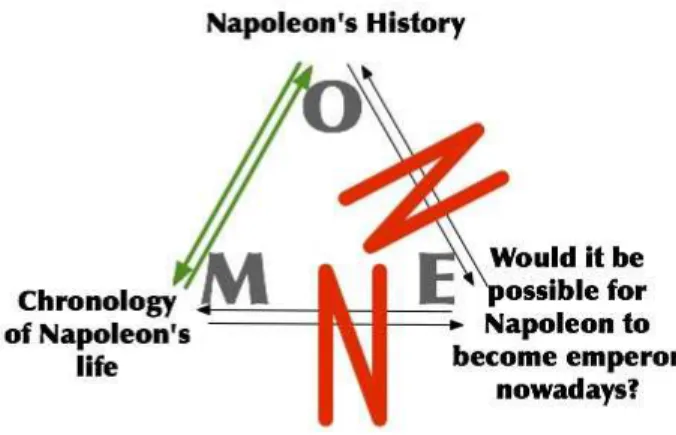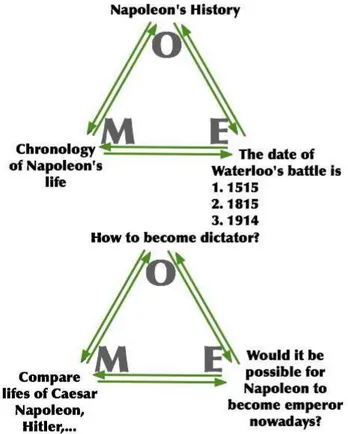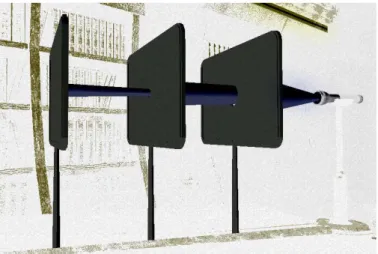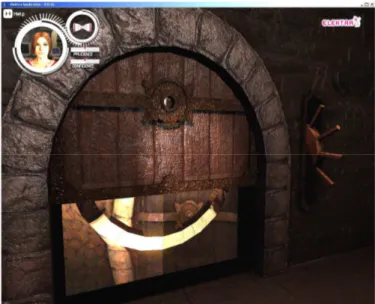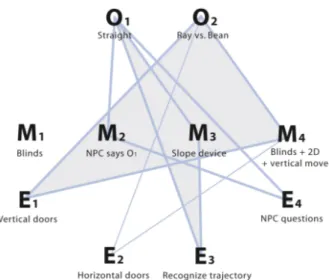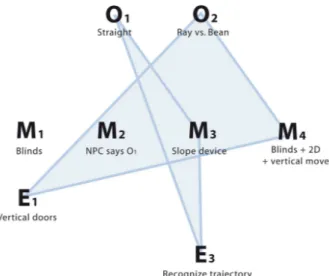This is the authors’ postprint version of: Castaigne, J-L, Petit, L., & Verpoorten, D. (2007). Introducing teachers and instructional developers to learning objects Four suggested shifts in prevailing discourse. In A. Targamadze (Ed.), Proceedings of the Advanced Learning Technologies and Applications conference (ALTA’2007) (pp. 73-79). Kaunas, Lithuania, Technical University Kaunas. ISBN: 978-9955-751-07-9
CHECKING THE INTERNAL PEDAGOGICAL CONSISTENCY OF A
GAME LEARNING SITUATION: THE LECLERCQ’S TRIPLE
CONSISTENCY TRIANGLE
Castaigne Jean-Loup, Petit Laurent, Verpoorten Dominique
Support Lab for Telematic Learning (LabSET), Bvd. de Colonster, 2 - B9, 4000 Liège (Sart-Tilman), Belgium. Tél. : 00 32 4 366 20 93
Annotation
1
Abstract
Leclercq’s triangle is a conceptual tool used for securing the pedagogical validity of learning situations. It materializes the sound pedagogy principle which commands to establish a triple consistency between objectives, methods and evaluation in any given learning situation. The ELEKTRA1 adventure game provides a practical illustration of its relevance.
2
Definition of triple consistency
Up-front choice of reference pedagogical frameworks allowing instructionally informed decisions is a key success factor when developing any kind of virtual learning environments (Koper & Olivier, 2004; Martinez, 2002; Wiley, 2000). This emphasis is taken up by authors in the field of digital game-based learning (Bopp, 2006; Kiili, 2004; Moser, 2000). Without such educational beacons, risks are high of lacking vocabulary for describing and implementing pedagogical endeavours, ultimately loosing instructional focus. Leclercq’s triple consistency triangle presented here is one of those conceptual guidelines, handling three crucial levers of the learning process.
Drawing on Tyler's argument (1949) that there is a need for consistency between objectives, methods and evaluation, Leclercq (1995) formalized the "triple consistency principle" between:
• Learning objective (O) and
• Method used to teach (M) or
• Evaluation strategy to test the level of objective’s knowledge reached (E).
Leclercq (1995) illustrates the principle into a model: Leclercq’s triple consistency triangle illustrated in figure 2.1. Leclercq (1995) stated that if OM and ME are consistent then O and E are de facto consistent.
Figure 2.1. Leclercq’s triple consistency triangle (theoretical model), illustration from Castaigne (2001)
When objective, method and evaluation are consistent, a triangle can be drawn in between them.
3
Example of triple consistency
Based on Leclercq’s model, Castaigne (2001) offers an illustration: if a teacher has for objective transmission of knowledge of Napoleon’s history, and teaches this in a chronological way (list of facts and dates), we may assume that there is consistency between objective and method (see figure 3.1). Let’s imagine that the evaluation is an open question like “would it be possible for Napoleon to become emperor nowadays?”. The question in itself is a very good question, but consistent neither with the objective nor with the method.
Figure 3.1. Non respect of triple consistency (triangle is broken) despite method being consistent with objective, illustration from Castaigne (2001)
Doing this way, we will face two problems:
1. We may encounter a lot of students failing this test.
2. Moreover, we can not guarantee that the students who passed the test will achieve the initial objective (knowing Napoleon’s history).
So, the teacher should (see figure 3.2)
• either keep the question and change the learning objective (like “Understanding the path to dictatorship”) and the teaching method (“like comparing the life of Caesar, Napoleon, Hitler, …”);
• or keep the objective and method and thus change the evaluation (like using multiple choice questions to assess links between dates and facts of Napoleon’s life).
Figure 3.2. Illustrations of triple consistent triangles improved from figure 2, illustration from Castaigne (2001)
4
State of O – M – E in ELEKTR A ‘s game at the time of the analysis
Labset's time was mainly absorbed by the design and the continuous pedagogical quality control of ELEKTRA’s game basic demonstrator. Development of the first learning situations in the game encountered some problems2. In this context, Leclercq’s triple consistency triangle demonstrated as a useful tool allowing to rationalize the presentation of a learning situation (overall pedagogical transparency), to keep instructional focus, to launch discussion with non pedagogues (shared vocabulary and common vision of the status of the situation), to correct them in order to enhance overall pedagogical quality and keep instructional focus. Following a thorough analysis of current objectives, current methods and current evaluations in the learning situation within ELEKTRA’s game, we drew observations wrapped up in the following tables dealing with each component of Leclercq’s triple consistency triangle
4.1 Objectives
"Crawford sees all computer games as educational – the only question is whether or not the facts and skills learned will have any application outside the game. With this in mind, his first rule of design is to select a goal for the game. The goal should be one for which the game designer has strong feeling and interests, as this passion will be evident in the final product. (...) This one overriding concept then becomes the yardstick on which all else is judged for inclusion; does it further the game’s goal? If not then it is to be left out, regardless of how inventive an idea may seem. The next step is to choose a setting which will enable to be best expressed while engaging the emotions and curiosity of audience". (Crawford, 1984; Moser, 2000)
Actually, none of the components of a learning situation (objective, method, evaluation) is sufficient per se3. ELEKTRA’s triangle forces to assess the interplay and cross-reference between them. For a specific learning situation within ELEKTRA’s game two objectives are to be covered:
O1 To understand light propagates in a straight line.
O2 To understand differences between ray4 of light and beam5 of light.
2
The relationships between the use of video games and learning are widely explored in two literature review (Mac Farlane, Sparrowhawk, & Heald, 2002; Mitchell & Savill-Smith, 2004).
3 Triple consistency deals with the three components together. But, when it comes to scrutinize one of them
individually, one needs dedicated conceptual tools. As for ELEKTRA project, the reference model tied to methods is the 8 Learning Events Model (Leclercq & Poumay, 2005; Verpoorten, Poumay, & Leclercq, 2007). The reference model tied to objectives is Bloom's taxonomy (Bloom, 1956).
4.2 Methods
In ELEKTRA’s methodology various partners creates learning situations. It is up to the pedagogical partner to give recommendation to ensure pedagogical validity but respecting other constrains like story telling, gaming flow, …
The methods that were created to cover the objectives were
M1 Manipulating blinds with holes to create a narrow beam of light to illuminate a screen.
On the right size of a rail is positionned a flash light, it can be switched on or off. The learner can manipulate a screen and several blinds (screens with a hole in the centre, holes have different sizes). By positioning the screen and the blinds on the rail, learner must produce a narrow beam of light on the
screen. To achieve that goal the scenario creator suggests placing the screen at the light opposite side of
the rail (Fig 4.1). In between and still on the rail the player should place the blind with the biggest hole on the side closest of the flash light. And the smallest hole closer to the screen. The player should place the screen and the two blinds in the correct relative position. As soon as he succeeded doing so the non playing character appears explaining: “so you see what the difference between a ray and a beam is!” The player is invited to horizontally move both blinds along the rail and observe the modification of the light cones. Doing so the player is supposed to understand the differences between a ray and a beam of light
Figure 4.1. Learning situation with blinds and screen: the solution from the situation creator’s point of view.
M2 A non-playing character (NPC) says to the player that light propagates in a straight line.
Obviously, the animated non-playing character informs the learner about how light propagates, just by talking. This method is easier to understand but is not really well integrated in the game flow.
4.3 Evaluations
To respect the game flow ELEKTRA’s partners implement evaluation procedure within the game and try to avoid as much as possible questions directly asked to the player. The evaluation proposed consists in opening a metal door equipped with light sensors (Fig 4.2). Only the one central sensor should receive light to open the door. In front of that metal door is a wooden door that the player can lift up or down. In the middle of the wooden door there is a hole the size of the middle sensor on the metal door. The player is supposed to move up the wooden door until the hole faces the middle sensor. Then putting his own flash light in front of the hole light will reach the central sensor only achieving the test.
4
A ray of light is a conceptual representation of light into a line (in the sense of what a line is in geometry). It is used in mathematical representation of light and helps in formulating laws like reflexion or refraction, but a single ray of light does not exist in real life.
5 A beam of light is how light behaves in real life, propagating from a source of light as a cone made of an
infinite amount of rays of light. When representing a beam of light on paper, physicians usually draw the external shape of the cone, made of 2 conceptual rays of light.
Figure 4.2. The wooden door is halfway up revealing the bottom part of the metal door. The hole in the wooden door is
visible but the sensor on the metal door isn’t.
At this point of development the evaluation within ELEKTRA’s game is limited to E1 Opening the metal door with the wooden door limited to vertical moves.
5
State of O – M – E in ELEKTR A ‘s game at the time of the analysis
Receiving the propositions of methods and evaluation we evaluate their consistency wich each other. We expected to find consistency between
• O1 with either M1 or M2 and with E1
• O2 with either M1 or M2 and with E1
Consistency was found between
• O1 and M2: since method consists in just declaring what the objective wants to teach, the method is
obviously consistent with the objective.
• O2 and E1: the evaluation can be succeeded only when the learner moves the wooden door in front of
the metal door, changing the beam of light into a thin beam of light (that becomes like a ray of light).
Figure 5.1. consistent relations between proposed objectives (O1 and O2), methods of teaching (M1 and M2) and
evaluation strategy (E1)
It was impossible for us to draw any of the two expected Leclercq’s triple consistency triangle. We informed our partners that we thought gamer/learner might face problems trying to open the metal door with the wooden door limited to vertical moves (E1) with the formation they have received in manipulating blinds with holes (M1) and
hearing a non playing character saying that light is propagating in a straight line (M2). We faced a lot of
6
State of O – M – E in ELEKTR A ‘s game at the time of the analysis
Keeping the same objectives we offered 2 new learning situations and 3 new evaluation situations within the game making possible to draw 3 Leclercq’s triangle allowing the partners to choose whatever situation best fit with story telling and game flow.
6.1 Objectives
Objectives could not be changed to get consistency with method of teaching or with evaluation strategy. It is important to note that objectives were classified and categorized with Bloom’s taxonomy (1956).
6.2 Methods
Two additional learning situations we proposed, as pedagogical partner, were M3 The slope device.
A machine makes marbles rolling down a slope. When a rolling marble quits the slope, it falls down on the ground. The aim of the learning situation is to counteract the gravitational force thanks to wind produced by a fan and magnet force produced by a magnet, making such that the marble goes in a given target. There are 5 marbles from different materials (wood, plastic, iron, stone, hollow iron).
M4 Manipulating blinds, screen and source of light, being able to switch light on/off, having a 2D-view.
Same method as M1 but with the ability to switch the torch light on/off and a 2D-view that reproduces the
life configuration on a 2D map.
We suggested to replace the two previous learning situation with those two new methods. In ELEKTRA one of the challenges was to avoid the caricature of learning software where teaching and playing are clearly two different things. In this respect learning method M2 (non playing character says to the player that light is
propagating in a straight line) was to obviously a teaching part. We suggested keeping it in case of failure of learning after experimenting with the slope device (M3).
6.3 Evaluations
Three new evaluation situations were proposed in consistence with the newly created learning methods. E2 Wooden door able to move both horizontally and vertically.
The evaluation with both horizontal and vertical moves of the wooden door would make the experiment (with blinds) similar to the opening of the metal door.
E3 Choose the drawing that represents the way light will propagate with the influence of gravity, wind and
magnetism.
It is a specific evaluation that will match with M3 (slope device) and that has to be embedded in the
learning situation itself. Principle is to propose the learner multiple choices questions like “When laser will be switched on under influence of magnet and fan, which trajectory do you think it will have?”.
E4 A “Yes or No” question related to M2 (a non playing character says to the player that light is propagating in
a straight line).
This evaluation does not give the entire guarantee she/he is honest (subjective evaluation).
7
Analysis with the new O – M – E
This work resulted in a representation which offers a visual status of the achievements and shortcomings of the learning situation. Objectives, methods and evaluations can be related with logical links. These links are showing where we have triple consistency and where we have isolated elements (objectives, methods or evaluations that are not linked to O, M, E in a Leclercq’s triple consistency triangle). The existence of a link does not describe when learning method is rich or poor but only if it is consistent with an objective or an evaluation method.
Figure 7.1. Four Leclercq’s triple consistency triangle
Figure 7.1 shows that some objectives, methods and evaluations are linked. In order to design correctly learning situations we have to take into account triangles, meaning consistency between an objective, a method and an evaluation. So from a situation with no consistency between objective, method and evaluation, we informed partners about the problem and designed new learning and evaluation situations to create consistency (since objectives are frozen). Four Leclercq’s triple consistency triangles appear in the situation we were proposing:
1. O1 M2 E4, a method already implemented into the game
2. O1 M3 E3, a new method to be implemented
3. O2 M4 E2 that requires adaptation of M1 and E1
4. O2 M4 E1 with a risk of not fully evaluating if the objective is reached
It obviously appeared that M1 was isolated and linked neither to any objective listed nor to any existing
evaluation, what was considered as a major pedagogical problem. We suggested therefore distinguishing both objectives O1 and O2, to link them to specific methods of teaching and evaluation. We previously explained that
1. it was not likely that E1 could evaluate the defined objectives,
2. M1 was a learning situation too complex and couldn‘t be considered as the only one learning situation to
reach the objective,
3. M2 was generating a learning situation not adapted to the game-based learning environment.
Communicating with Leclercq’s triple consistency triangles helped a lot, partners understood the problem the ELEKTRA project was facing having O1 M1 E1 as only available situations. It helped as the designed teaching
and evaluation were not bad or good but not likely consistent with each other. Being able to represent actual situation and propositions with Leclercq’s triple consistency triangles was a major step resolving the pedagogical problem within the game.
Out of the four triangles in Figure 7.1 we consider two of them as significant; they are coloured (O1 M3 E3) and
(O2 M4 E2). This means that we think “Understanding that light propagates in a straight line” (O1) is likely to be
possible using “the slope device” as teaching method (M3) and is well evaluated “Answering NPC’s questions
“amongst these drawing describing trajectories, which one will apply when you turn on the light?” (E3). Because
this learning situation includes the first objective, we consider it as essential. The second coloured triangle consists of a second learning situation and is based on the second objective. It means we agreed that “to
understand the differences between ray of light and beam of light”, the implementation of both the possibility to turn on or off the flash light and providing a top view with comments to analyse what the learner sees will transform M1 into a suitable teaching method. We also agreed that the evaluation (E1) will be more consistent
with the teaching method if it was possible to move the wooden door the same way the blinds are moving. By adding horizontal moves to the current vertical moves of the wooden door, we make similar the evaluation and the method of learning. The introduction of 2D-view during the experiment (M4) matches with the notion of ray
of light. 2D-view is also an import method of learning that anticipates the next learning units where the player will have to represent orbits and planets in a plane view.
The other two are not coloured (O1 M2 E4 and O2 M4 E1). Despite being consistent we consider them less
significant because
• O2 M4 E1 is not well evaluated to assume that O2 is understood.
We suggested that those last two triangles were either adapted or removed. Adaptations are proposed in changing M1 into M4 and E1 into E2.
All partners understood well better the situation in terms of pedagogical point of view because we used a graphical representation using Leclercq’s triple consistency triangle. For they understood the problem the following decision were taken:
• Being designed in 3D, the M1 learning situation with the blinds was kept as a possible experimentation.
• It was decided to create both M3 and E3 situations to cover objective O1.
• Learning situation M2 was kept as a backup solution.
• We abandoned the O2 M4 E2 consistent triangle because the situation where the wooden door moves
horizontally is not reflecting the reality and player may wonder why it would happen like this. The representation that the player has from a Middle-Age wooden door is more conform to an up and down moving door.
Figure 7.2 presents to situation after the decision of the partners with two Leclercq’s triple consistency triangles implemented in the ELEKTRA’s game.
Figure 7.2. the two remaining Leclercq’s triangle within ELEKTRA’s game
8
Conclusion
We see Tyler’s theory and Leclercq’s model and representation as a foundation for reaching pedagogical
integrity and legitimating design interventions according to learning objectives. The principle of Leclercq’s triple consistency and its operationalization through the ELEKTRA project allowed both the identification of a lack of consistency between objectives, methods and evaluations and an efficient communication tool to express pedagogical point of vue to non-pedagogues. This is not trivial: the diagnosis conducted with this conceptual tool reveals a dramatic threat on the possibility of learning and on the possibility to have a control of what is learnt in the game. Improvement decisions on learning content, learning methods, learning evaluation could be taken based on this effort of pedagogical "triangulation".
Literature
Bloom, B. (1956). Taxonomy of Educational Objectives, Handbook I: The Cognitive Domain. New York: David McKay Co Inc. .
Bopp, M. (2006). Didactic Analysis of Digital Games and Game-Based Learning. In M. Pivec (Ed.), Affective and Emotional
Aspects of Human-Computer Interaction. Game-Based and Innovative Learning Approaches (pp. 8-37). Amsterdam:
IOS Press.
Castaigne, J.-L. (2001). Non nova, sed nove : mise en place d’un nouveau système d’apprentissage et d’évaluation en
reproduction animale. Université de Liège, Belgium.
Crawford, C. (1984). The art of Computer Game Design. Retrieved 29-08, 2007, from http://www.vancouver.wsu.edu/fac/peabody/game-book/Coverpage.html
Kiili, K. (2004). Digital game-based learning: Towards an experiential gaming model. Internet and Higher Education, 8(1), 13-24.
Koper, R., & Olivier, B. (2004). Representing the Learning Design of Units of Learning. Educational Technology & Society,
7(3), 97-111.
Leclercq, D. (1995). Conception d’Interventions et Construction de Produits pour la formation. Université de Liège, Belgium. Leclercq, D., & Poumay, M. (2005). The 8 Learning Events Model and its principles. Retrieved July 2007, from
http://www.labset.net/media/prod/8LEM.pdf
Mac Farlane, A., Sparrowhawk, A., & Heald, Y. (2002). Report on the educational use of games. An exploration by TEEM of
the contribution which games can make to the education process. Cambridge: Department for Education and Skills -
TEEM project.
Martinez, M. (2002). Designing learning objects to personalize learning. In D.A. Wiley (Ed.) The Instructional Use of
Learning Objects (pp. 151-173). Bloomington: Agency for Instructional Technology.
Mitchell, A., & Savill-Smith, C. (2004). The use of computer and video games for learning. A review of literature. UK: Learning and skills development agency.
Moser, R. (2000). A methodology for the design of educational computer adventure games. http://www.library.unsw.edu.au/~thesis/adt-NUN/public/adt-NUN20021003.141152.
Tyler, R. (1949). Basic principles of curriculum and instruction. Chicago: University of Chicago Press.
Verpoorten, D., Poumay, M., & Leclercq, D. (2007). The eight learning events model: A pedagogic conceptual tool supporting diversification of learning methods. Interactive Learning Environments, 15:2, 151 - 160.
Wiley, D. (2000). Connecting learning objects to instructional design theory: A definition, a metaphor, and a taxonomy. Retrieved 29-08-2007, from http://reusability.org/read/chapters/wiley.doc.
